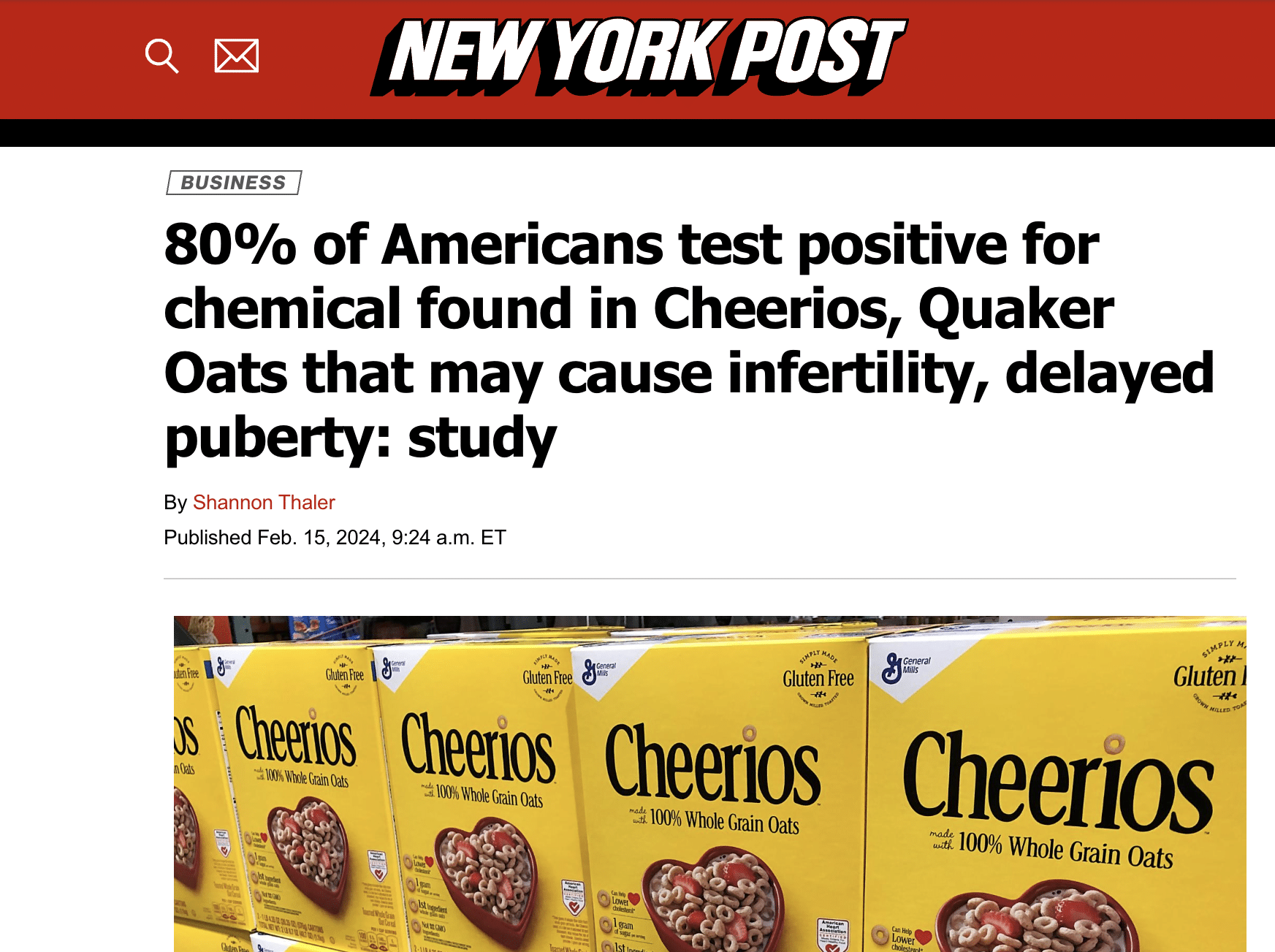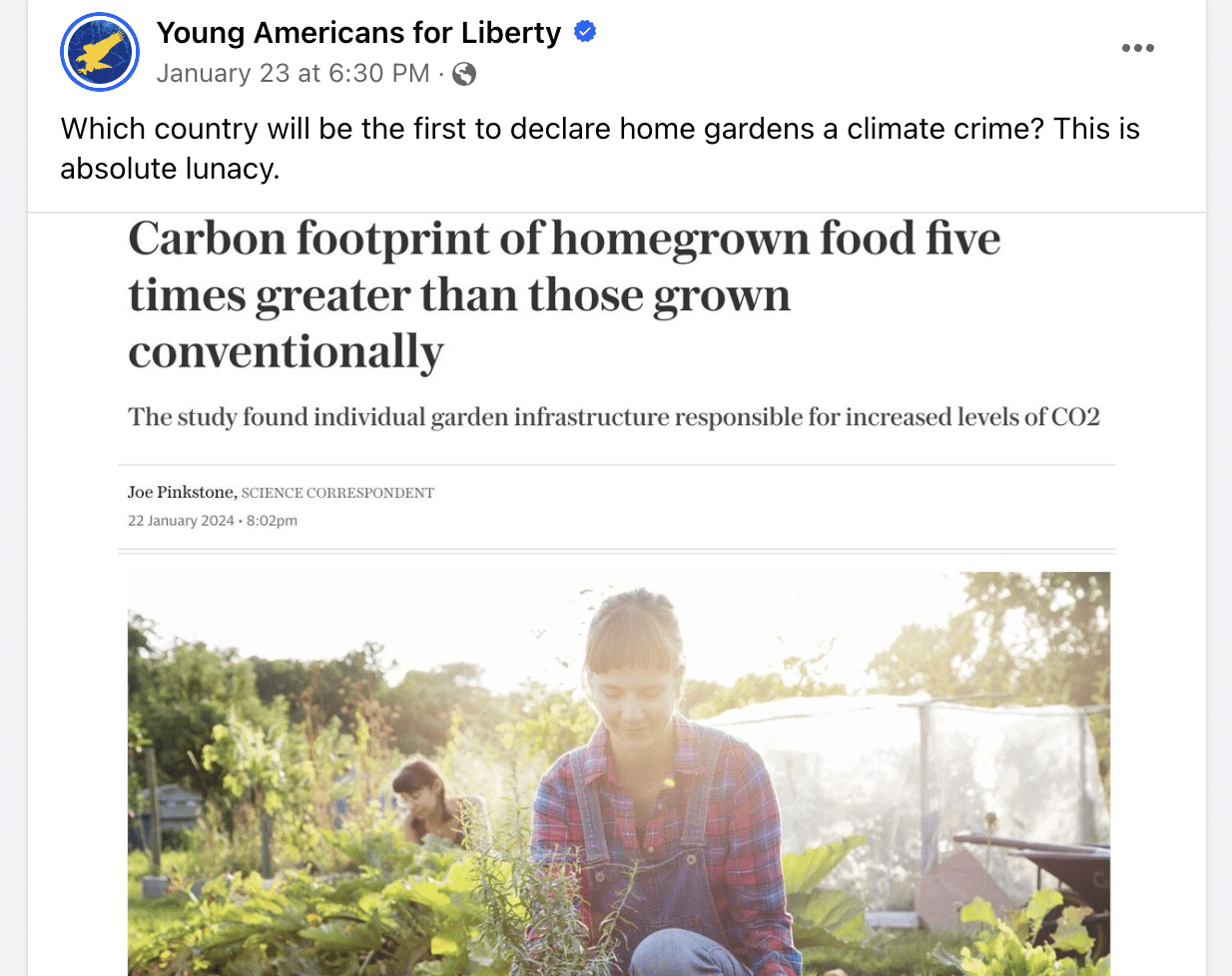- Climate
Viral claim that cow burps are not an important contributor to climate change ignores full range of greenhouse gas emissions of beef production
Key takeaway
Reducing methane is critical to achieving global climate targets. Conventional beef and dairy production is a significant contributor to climate change through the release of greenhouse gasses like methane from cow burps. The EPA greenhouse gas estimate does not include land use related emissions from livestock agriculture, which is one of the most impactful aspects of beef production on climate change in addition to cow burps. Methane is a more potent greenhouse gas than carbon dioxide. As beef production increases, so do global methane emissions. The high quantity of cows and the high global warming potential of methane is what makes cow burps impactful on climate change.
Reviewed content
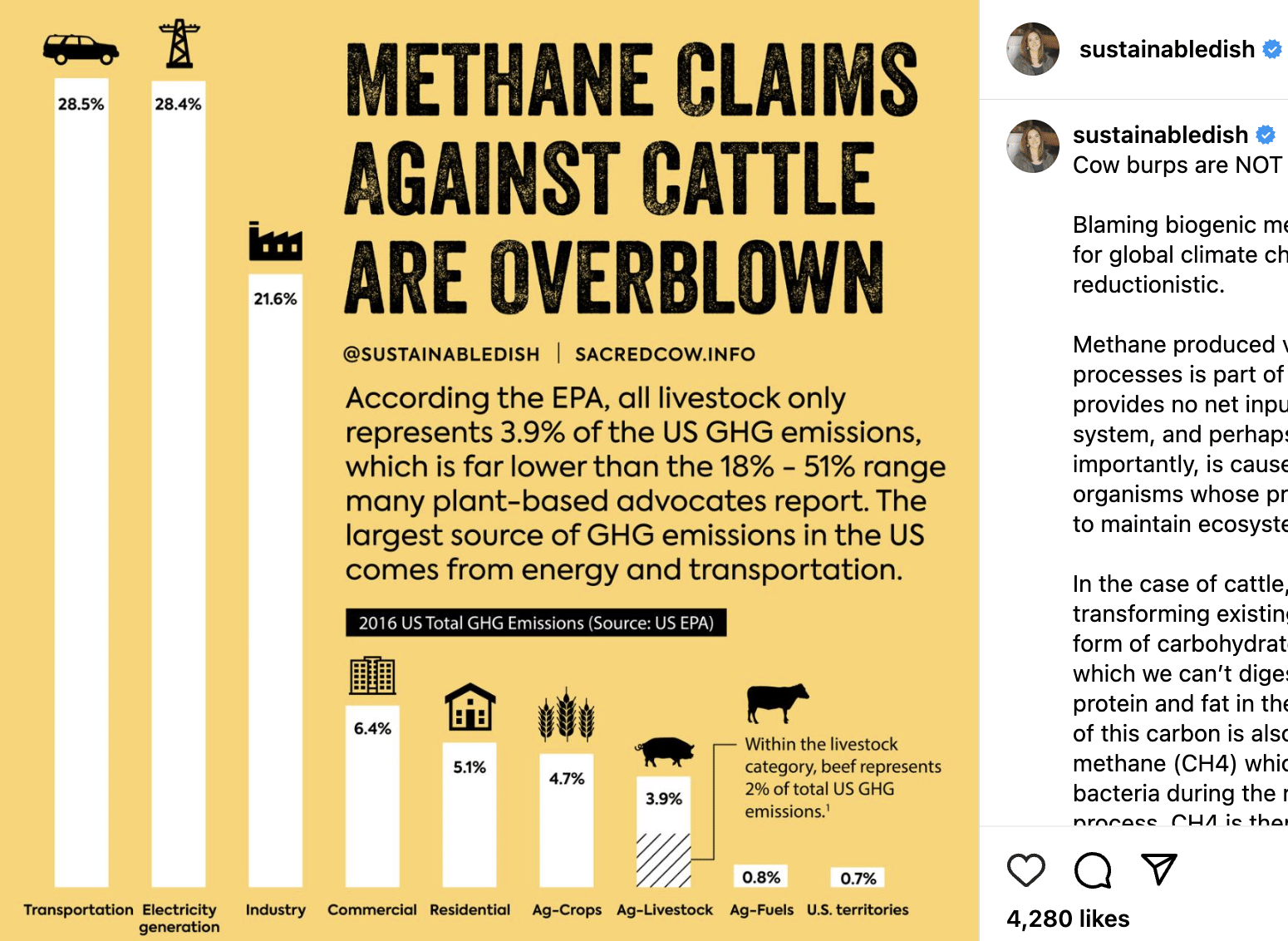
Verdict:
Claim:
Methane from cows is only a small percentage of total greenhouse gas emissions, it would be produced anyways without cattle, it is not an important contributor to climate change
Verdict detail
Misleading: Estimates of livestock greenhouse gas emissions do not include land use related emissions, which is one of the most impactful aspects of beef production on climate change. Even so, the seemingly small percentage attributed to US livestock agriculture is still globally relevant because total US emissions are so high.
Lacks context: Livestock burps, flatulence, and manure produce 32% of global anthropogenic methane emissions, which drives significantly more warming than carbon dioxide during its relatively short lifetime on a per molecule basis. As beef production increases, so do global methane emissions.
Factually inaccurate: Cows are ruminants meaning their stomachs provide ideal anaerobic conditions for the production of methane. The high methane emissions due to the planet’s 1.46 billion domesticated cows would not occur without humans raising such a large number of them.
Full Claim
Methane claims against cattle are overblown because all emissions from all livestock is only 3.9% of total US greenhouse gas emissions according to the EPA estimate. The emitted methane comes from grass, leaves the atmosphere after 10 years, and then returns to help grass grow. Much of the methane emissions would occur anyways outside the digestive tract of cows.
Agriculture is the largest anthropogenic source of methane (CH4) emissions. Livestock agriculture which takes up 80% of global agricultural land but produces less than 20% of the world’s supply of calories, represents about a third of these emissions. It has a much larger emissions profile and impact on climate change than just cow burps. Conventional beef and dairy production results in significant amounts of greenhouse gas (GHG) emissions, which is why improving practices and reducing meat consumption are recognized strategies to mitigate climate change.
But in a recent viral Instagram post from 19 December 2023 liked more than 4,000 times, it was claimed that cattle livestock agriculture is not a significant contributor of greenhouse gas emissions. We explain below how this claim is misleading because it fails to account for the full range of emissions linked to beef and dairy production, in addition to methane from cow burps. We also outline how the post caption contains other statements that lack necessary context and are factually inaccurate.
The total emissions profile of livestock agriculture is larger than EPA estimates because of land use impacts
Agriculture contributes around 10% of all US GHG emissions. In the latest US Environmental Protection Agency’s (EPA) GHG inventory report, livestock agriculture contributed 4.4% of the 6,340.2 million metric tons of CO2-equivalent (CO2-eq) the US emitted in 2021, mostly from enteric fermentation (cow burps) and manure management. The high total emissions of the US may create the impression that livestock agriculture is a relatively small contributor; research has shown that the US meat and dairy industry uses this to undermine climate-related policies[1]. However, 4.4% is still 278.3 million metric tons emitted by US livestock agriculture alone, equating to 69% of the GHG emissions of France for all sectors for the same year, for instance.
Furthermore, the use of these EPA estimates to downplay the impact of livestock agriculture on climate change is misleading because they do not include all indirect emissions of CH4, nitrous oxide (N2O), and carbon dioxide, which are significant in the agricultural sector. In addition to enteric fermentation (e.g., cow burps), livestock agriculture involves multiple greenhouse gas emissions sources, such as emissions from manure management (e.g., manure lagoons), feed production (e.g., fertilizer emissions), the energy required to maintain livestock production (e.g., ventilation), and livestock processing and retail (e.g., slaughter and packaging). These all relate to livestock agriculture, but one of the largest emissions sources is still missing: land use impacts.
Many GHG estimates typically do not consider the land use impacts of livestock agriculture, despite the fact that it requires extensive land resources. This is the case for the EPA’s estimates. The croplands dedicated to growing livestock feed in the US alone, which is unsuitable for human consumption, cover around three-quarters of the country and involve intensive practices that prioritize yields and negatively affect much of the country’s soils and waterways[2]. Land use impacts in livestock agriculture are especially important for beef production (see Figure 1).
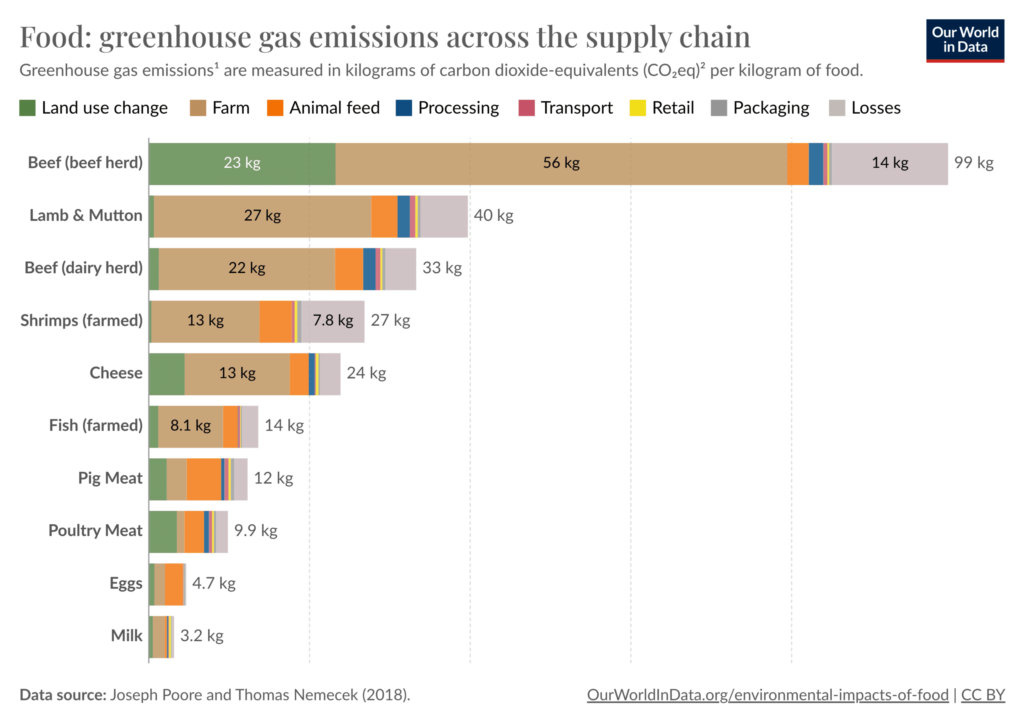
Such extensive land resources dedicated to intensive and environmentally degrading livestock agriculture are blocked from being used to maximize ecosystem carbon sequestration above- (trees and plant biomass) and belowground (soil organic matter). Natural carbon sinks from landscape conservation and restoration are a vital piece of the climate change mitigation puzzle to reduce the impacts of other major sources of GHG emissions, like the transport sector[3]. Land used to intensively grow livestock feed is also land that could be used for producing food suitable for humans to offset meat consumption reductions or crops to foster biofuel production.
Expansion of grazing lands and croplands for livestock feed production means less natural vegetation and often much less carbon storage and more carbon emissions. Increases in the demand for beef products within the US can also result in deforestation for pastures in other countries, as beef is a global commodity. Beef production is the leading driver of tropical deforestation, with 2.1 million hectares converted to pastures each year. The lost opportunities for natural carbon sinks and the GHG emissions from land use changes within and beyond the US linked to beef consumption is not represented in the EPAs 4.4% estimate.
Including land use and land use change impacts from livestock would significantly increase its emissions profile estimate. For example, considering the average American is ranked second globally for total meat consumption and third for beef consumption, the World Resources Institute estimated the total GHG emissions from the average American-style diet. By including indirect emissions from land-use-change in addition to direct emissions, the total was found to be within the range of per capita energy-related emissions. This indicates that agriculture, primarily because of the total emissions profile of livestock agriculture, can be as impactful for climate change as one of the largest sectors: energy.
The total (all direct and indirect emissions) impact US livestock agriculture on top of the EPA’s limited estimate of 4.4% has not yet been robustly calculated. Fortunately, we do have some ideas on how including land use impacts change livestock emission values on the global stage. The FAO estimated that livestock agriculture alone contributes 12% of global GHG emissions in its latest data analysis, with 3.6 billions of tons (Gt, gigaton) of CO2-eq of direct emissions and 6.2 Gt CO2-eq of total emissions (when the full supply chain is considered). Peer-reviewed studies estimate livestock’s contribution at around 15-19% of global emissions, much higher than the EPA’s limited estimate of 4.4%[4-5].
The broader category of “agricultural, forestry, and other land use” is responsible for more than a fifth of the world’s GHG emissions according to the latest IPCC report[6]. This is mainly from land use change (e.g., deforestation for pasture), enteric fermentation (e.g., cow burps), poor pasture and manure management, and nitrogen fertilization. All these factors are linked to beef production. The entire food system, from cultivation, transport, processing, retail, and consumption, contributes 34% of global GHG emissions. Nearly three quarters of that comes from agriculture and its indirect land impacts. Overall, it is clear that cow burps (beef production) are indeed a significant contributor to climate change because they are a major component of agricultural sector emissions when all direct and indirect sources are considered.
Cow methane emissions contribute to global warming and would not occur naturally to the same extent
Cows are ruminant animals along with goats and sheep; they all release methane (CH4) through burps and flatulence as they digest plants like grass as a result of enteric fermentation. Their burps, flatulence and manure is estimated to contribute 32% of anthropogenic CH4 emissions, and about 40% of global GHG emissions from the agricultural sector in 2011. Contrary to popular belief, cow burps release far more methane than their flatulence. Manure CH4 and N2O emissions represent 7% of global agricultural GHG emissions in 2011. Although CH4 only lasts around 10 years in the atmosphere, it is a much more potent greenhouse gas compared to CO2 and causes long-term damage to climate change mitigation efforts.
After being released and within those 10 years, CH4 naturally degrades in the atmosphere through methane oxidation. Chemically, CH4 reacts with ozone to form carbon dioxide and water. Methane-consuming bacteria (methanotrophs) in soil and water can also remove CH4 if in contact. The CO2 and water byproducts of atmospheric CH4 oxidation can then be taken up by ecosystems, for example by photosynthesis in grass to then be consumed by cows, completing this small part of the biogenic carbon cycle.
However, this relatively short lifespan and the potential uptake of its oxidized byproducts by plants does not mean CH4 has a neutral impact on global warming. Some context is missing that demonstrates why CH4 methane emissions from cow burps are a significant driver of climate change. First and foremost, the 10 year lifespan of CH4 in the atmosphere is less important than its global warming potential. Why else would one of the world’s largest agribusinesses, Cargill, be investing in cow wearables (i.e., masks) to “tackle methane emissions in the dairy industry”?
One molecule of CH4 is over 80 times as potent as one molecule of CO2 in trapping heat in the atmosphere and strengthening the greenhouse effect in the short-term. Even after CH4 oxidizes into CO2, the global warming effect of the original cow burp will continue as CO2 until it is finally photosynthesized by plants. Considering the short-timeframe left for emissions reductions to limit global temperature increase to 1.5°C, any new CH4 emitted to the atmosphere from cows has negative and immediate consequences for climate change mitigation.
Second, the fact that CH4 is released by ruminants naturally does not mean it is not an anthropogenic source of CH4 emissions. By drastically increasing beef and dairy production globally, humans have expanded the impact of ruminant CH4 emissions on the atmosphere. Simply put, more cows means more burps and manure which means more CH4 in the atmosphere, in addition to more of the other associated livestock agricultural emissions driving global warming such as land use impacts (e.g., CO2 and N20).
The absolute increase and quantity of GHGs is what is most relevant. All human activities have more than doubled atmospheric CH4 over the past 200 years. A single cow produces between 70-120 kg of CH4 gas per year. There are 62% more cows in 2021 than there were in 1961. When all the burps and associated agricultural emissions are added up for today’s 1.46 billion cows, they were responsible for 3.8 Gt of CO2-eq in GHG emissions in 2015.
It is also important to clarify that quantities of CH4 emitted by cows in livestock agriculture are not comparable to natural ecosystem CH4 emissions, like from wetlands, geologic seepage, wild animals, termites, wildfires, and permafrost. As CH4 emissions from livestock is an anthropogenic GHG emissions source, this means humans can modify it in an effort to mitigate negative impacts of climate change. Modifying truly natural global-scale CH4 emissions is outside human capabilities, both technologically and logistically.
But most importantly, the same scale of CH4 emissions from cow burps would not have occurred naturally as inaccurately claimed in the post. The digestive systems of ruminants like cows provide the optimal anaerobic conditions for CH4 production during enteric fermentation in the specialized “rumen” chamber, the largest part in their stomach (see Figure 2). As plant tissues ferment in the rumen by methanogen microbes for further digestion later, CH4 is produced and released as burps. This process does not occur easily outside of the rumen in landscapes where human managed cows, sheep, and goats consume vegetation.
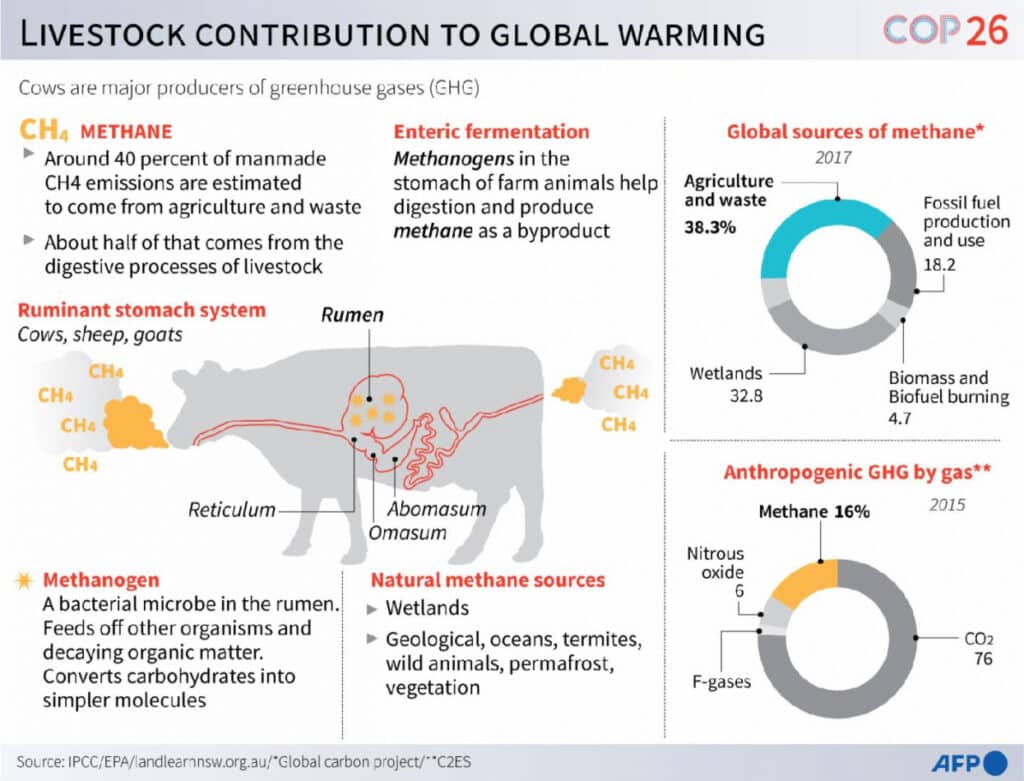
Non-ruminant CH4 production depends on environmental conditions. Anaerobic bacteria need to decompose biomass under anaerobic conditions, which occurs best in the water-logged soils of wetlands (the largest natural source of CH4 emissions). This would not happen naturally in the open grasslands and pastures used for ruminant grazing. In the US, most rangelands and some pastures occur in semiarid to arid climate zones, while the rest of pastures occur in humid and marginally semi-arid environments[7]. Wetlands are not conducive for livestock agriculture.
More cows digesting and fermenting plant tissues means more burping and manure production over pastures and in intensive feedlots. This results in new, additional atmospheric-CH4 that would not have been chemically produced at the same location and to the same extent even when wild ruminants are considered. Wild ruminants in the US like bison, elk, and deer only emit around 4.3% of the emissions from domesticated ruminants, and even pre-settlement wild ruminants only emitted around 86% of today’s domesticated ruminants[8].
Despite misleading claims that cow emissions is just existing carbon that is cycled whereas fossil fuel emissions is new carbon that is added, both of these sources add new carbon to the atmosphere that would not have otherwise been released without human involvement. Any new CO2 and CH4 carbon in the atmosphere will have a warming effect until they are cycled into other carbon pools, regardless of their origin. Emissions are only carbon neutral if they are in equilibrium with the cycle, but human activities have added more carbon than natural cycles can remove, which is why atmospheric GHG concentrations have risen so significantly.
Conclusion
Research has shown that reducing CH4 is critical to achieving global climate targets, both from fossil fuel sources and from livestock agriculture[9]. Conventional beef and dairy production in particular is a significant contributor to climate change through the release of greenhouse gasses like methane from cow burps. The claim that livestock agriculture, and the burps from cows resulting from beef and dairy production, are not as impactful for climate change as believed is misleading because it is based on GHG estimates that do not include land use related emissions. Even without land use impacts considered, the seemingly small percentage attributed to US livestock agriculture is still globally relevant because total US emissions are so high. Context is also missing in the claim that CH4 from cow emissions has a short-lifespan and is therefore not impactful. In reality, it drives significantly more warming than carbon dioxide during that time on a per molecule basis. As beef production increases, so do global methane emissions. The high quantity of cows and the high global warming potential of methane is what makes cow burps impactful on climate change. Finally, the claim that the same CH4 emissions would occur naturally without beef and dairy cows is factually inaccurate. The enteric fermentation process is unique to ruminants like cows and the methane emissions they produce would not otherwise occur in the pastures and grasslands where cows are raised. Overall, cows are managed by humans so their burps are an anthropogenic source of emissions.
REFERENCES
- 1 – Lazarus et al. (2021) The climate responsibilities of industrial meat and dairy producers. Climatic change
- 2 – Emery (2018) Without animals, US farmers would reduce feed crop production. Proceedings of the National Academy of Sciences
- 3 – Marvin et al. (2023) Natural climate solutions provide robust carbon mitigation capacity under future climate change scenarios. Scientific Reports
- 4 – Poore & Nemecek (2018) Reducing food’s environmental impacts through producers and consumers. Science
- 5 – Xu et al. (2021) Global greenhouse gas emissions from animal-based foods are twice those of plant-based foods. Nature Food
- 6 – IPCC (2023) Chapter 7: Agriculture, Forestry, and Other Land Uses (AFOLU). In: Climate Change 2023: Synthesis Report. Contribution of Working Groups I, II and III to the Sixth Assessment Report of the Intergovernmental Panel on Climate Change
- 7 – Ojima et al. (2020) A climate change indicator framework for rangelands and pastures of the USA. Climatic Change
- 8 – Hristov (2012) Historic, pre-European settlement, and present-day contribution of wild ruminants to enteric methane emissions in the United States. Journal of Animal Science
- 9 – Reisinger et al.(2021) How necessary and feasible are reductions of methane emissions from livestock to support stringent temperature goals?. Philosophical Transactions of the Royal Society A

